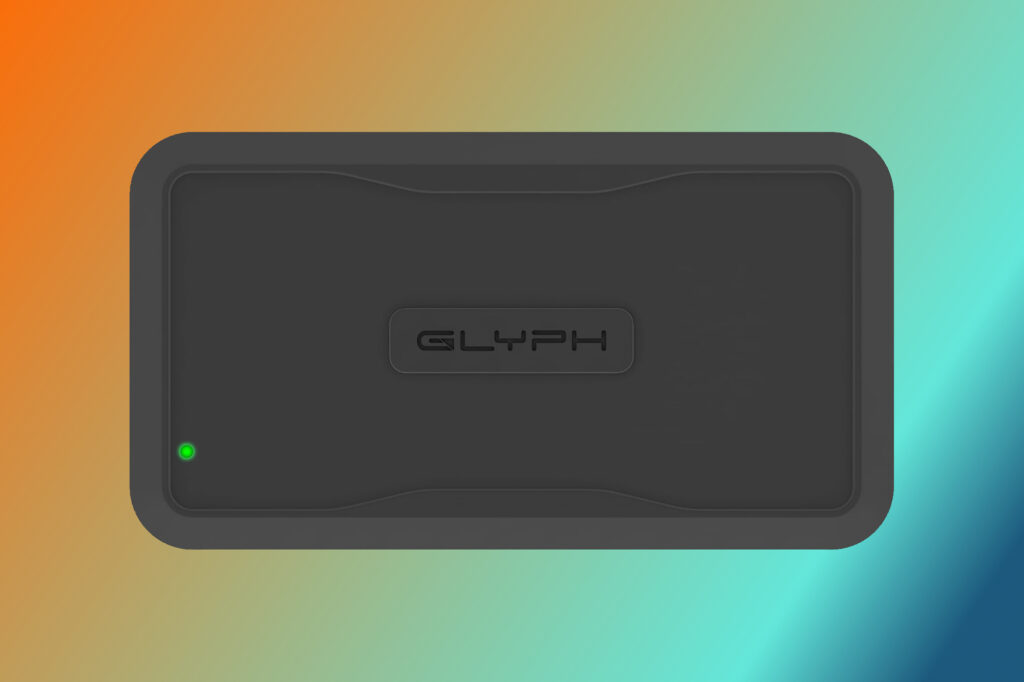Glyph Atom Pro Portable Thunderbolt 3 NVMe SSD V2 review: Fast, down-to-business Thunderbolt 3 storage

Expert’s Rating
Pros
Third-fastest Thunderbolt 3 SSD we’ve tested
Handsome, rugged design
Two years of basic data recovery
Cons
Rather pricey
Our Verdict
The Atom Pro SSD blew through our tests in short order and is a serious-looking piece of kit. But it’ll also set you back a serious chunk of change.
Price When Reviewed
This value will show the geolocated pricing text for product undefined
Best Pricing Today
Price When Reviewed
$270 (1TB) | $390 (2TB) | $600 (4TB) | $1,400 (8TB)
Best Prices Today: Glyph Atom Pro Portable Thunderbolt 3 NVMe SSD V2
In a world moving to USB4 and Thunderbolt 5, a Thunderbolt 3 SSD like Glyph’s Atom Pro Portable Thunderbolt 3 NVMe SSD V2 might seem a bit quaint. It ain’t. So far, we’ve noticed little real world performance gain from the newer technologies, so this drive is still more than competitive. We also like its stern-in-a-good-way looks.
The Atom Pro SSD is a smallish black aluminum monolith approximately 4.3-inches long, 2.35-inches wide, and an inch thick. It weighs in at 5.7 ounces bare, and 6.4 ounces with its silicone jacket. Out of the box, the jacket is in place and adds a few millimeters in every dimension.
The Atom Pro SSD is Thunderbolt 3 with NVMe internals. It sports a single Type-C port and a small power LED that peeks through a small hole in the jacket. Overall, it’s classy with overtones of foreboding–it looks like a serious piece of kit. It also feels solid, and the jacket gives you a good grip. A short Type-C to Type-C cable is provided.
Glyph warranties the unit for three years, with two years of level-one data recovery.
Price
While a quality product, I was expecting lower Atom Pro SSD prices, considering that Thunderbolt 5 and USB4 are gaining traction. Then again, the Atom Pro SSD is not a brand new product. Forgetting market analysis, it was shipping in 1TB/$270, 2TB/$350, 4TB/$560, and 8TB/$1400 flavors on Amazon as I put this review to bed.
I like the Atom Pro SSD, but I’d be neglecting my journalistic duties if I didn’t at least mention this far cheaper roll-your-own USB4 option. Additionally, the newer Thunderbolt 5 OWC Envoy Ultra was only ten bucks more at the time of this writing.
Performance
Being Thunderbolt 3, you know the Atom Pro is going to be fast. Glyph populated my test unit with a 4TB WD SN850X inside. It’s not as fast as the top-rated 8TB version, but still a very fast NVMe SSD.
With the SN850X on board, the Atom Pro SSD proved the third fastest Thunderbolt 3 SSD Macworld or PCWorld have tested, and one of the drives it sits behind is the OWC Thunderblade RAID SSD running in RAID 0–a sure performance boost.
The other drive to beat the Atom Pro SSD was the Sandisk Pro-G40 it was a close contest. Among all external SSDs, including Thunderbolt 4/5 and USB4 models, Glyph’s entry placed 11th.
Blackmagicdesign’s Disk Speed Test showed very balanced read/write performance from the Atom Pro SSD, around 2.7GBps.
AmorphousDiskMark (CrystalDiskMark for the Mac) rated the Atom Pro SSD as a faster reader, but anywhere near 3GBps is fine with us.
ATTO Disk Benchmark told pretty much the same story as Disk Speed Test and AmorphousDiskMark–just over 3GBps reading and just under when writing.
I also ran the Atom Pro SSD through PCWorld’s test MO (for purposes of comparison and ranking) and as noted, it did very well indeed. Again, just over 3GBps reading and just under when writing.
Random write performance hit a snag under CrystalDiskMark 8. 21MBps is a very low number, especially as the SN850X inside has DRAM for primary cache.
In our real world 48GB transfers, the Atom Pro proved to be an excellent reader, though only a very good writer.
The slightly slow writing did hurt the Atom Pro SSD a bit in the 450GB write, though it still averaged well over 1GBps.
Note that in subsequent 900GB writes, speed dropped to approximately 600MBps, which is the native write rate for the TLC BiCS 6 NAND on the SN850X. I don’t consider that a tragic slowdown, and how many times will you write over 1TB of data at once? We do during testing, but never other than that.
You might be wondering how the Atom Pro SSD compares to the newer Thunderbolt 5 OWC 5 Envoy Ultra. You can read more about the latter’s numbers in the review, but long story short: in synthetic benchmarks, the Envoy Ultra was supreme. In real world transfers, however, there simply wasn’t that much difference.
Kind of a sad state really. I did not include the Envoy Ultra’s numbers in the PCWorld charts as they were not gathered using the official test bed.
Should you buy the Glyph Atom Pro SSD?
If you’re looking for a fast external storage solution for your Mac, the Atom Pro SSD certainly deserves a look. But I’d also recommend that you try to find it on sale, and weigh all your options carefully.
How PCWorld tests storage
The PCWorld drive tests described above currently utilize Windows 11, 64-bit running on an X790 (PCIe 4.0/5.0) motherboard/i5-12400 CPU combo with two Kingston Fury 32GB DDR5 4800MHz modules (64GB of memory total). Both 20Gbps USB and Thunderbolt 4 are integrated to the back panel and Intel CPU/GPU graphics are used. The 48GB transfer tests utilize an ImDisk RAM disk taking up 58GB of the 64GB of total memory. The 450GB file is transferred from a 2TB Samsung 990 Pro which also runs the OS.
Each test is performed on a newly NTFS-formatted and TRIM’d drive so the results are optimal. Note that in normal use, as a drive fills up, performance may decrease due to less NAND for secondary caching, as well as other factors. This can be less of a factor with the current crop of SSDs with far faster late-generation NAND.
Caveat: The performance numbers shown apply only to the drive we were shipped and to the capacity tested. SSD performance can and will vary by capacity due to more or fewer chips to shotgun reads/writes across and the amount of NAND available for secondary caching. Vendors also occasionally swap components. If you ever notice a large discrepancy between the performance you experience and that which we report, by all means, let us know.




